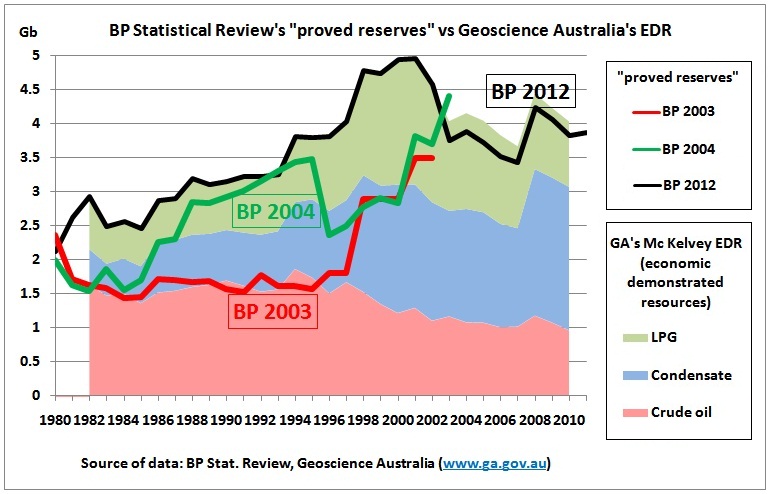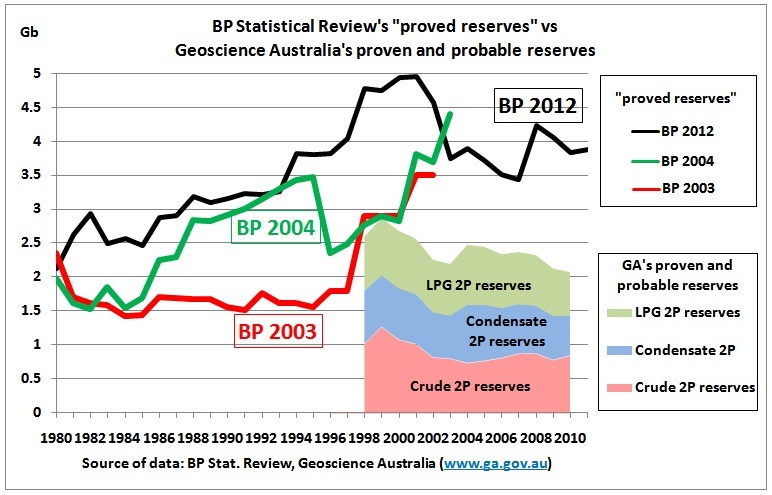This is easy to check. From the Geoscience Australia website (GA – Oil and Gas Resources of Australia – OGRA) we add total reserves (proved and probable = 2P) for crude oil, condensate and LPG to 2,077 million barrels for January 2011.
 http://www.ga.gov.au/products-services/publications/oil-gas-resources-australia/2010/reserves/table-1.html
http://www.ga.gov.au/products-services/publications/oil-gas-resources-australia/2010/reserves/table-1.html
But the latest BP Statistical Review shows for end 2010 a volume of 3,831 million barrels for proved reserves 1P
 http://www.bp.com/sectionbodycopy.do?categoryId=7500&contentId=7068481
http://www.bp.com/sectionbodycopy.do?categoryId=7500&contentId=7068481
while this should actually be lower than the GA number for 2P which means BP reports approximately 2 times what the GA data imply for proved reserves.
So what’s going on here? A cleric hick-up? Embellished statistics? Crude oil, condensate and LPG mixed up? Confusion over what oil reserves are?
Let’s have a look at the history of Geoscience Australia’s reserve data and compare it with the reporting in the BP Statistical Review.
1P reserves are not available but 2P reserves can be found on this website
http://www.ga.gov.au/products-services/publications/oil-gas-resources-australia.html
going back to 1998 in the OGRA 2000 report.We put all data into one graph.
This graph shows that – over the whole reporting period – BP’s “proved reserves” are much higher than GA’s 2P reserves of crude, condensate and LPG. We also see that the BP 2003 report (red curve) started on a low base up to 1997, then increased reserves by 60% in the following years. In the BP 2004 report (green curve), data were retrospectively revised upwards. In only 3 years 1998-2000 came these two BP reports close to GA’s 2P reserves. The BP 2005 and all the following reports (not shown) were close to the BP 2012 reporting (black curve)
So what is BP actually reporting on? The GA tables also contain data on resources based on McKelvey’s classification.
 http://www.ga.gov.au/products-services/publications/oil-gas-resources-australia/2010/reserves/table-2.html
http://www.ga.gov.au/products-services/publications/oil-gas-resources-australia/2010/reserves/table-2.html
We add 966 + 2,110 + 964 = 4,040 million barrels compared to BP’s 3,831 mb. So this is very close. But is this just a coincidence? How about the other years? GA’s data series for resources go back to 1982 in this file http://www.ga.gov.au/image_cache/GA6111.pdf
 GA’s data series for resources go back to 1982 in this file
GA’s data series for resources go back to 1982 in this file
http://www.ga.gov.au/image_cache/GA6111.pdf
What we see is that “proved reserves” in the BP 2012 report exactly match McKelvey’s resources on page 98 of the above report until 2003 and then follow broadly the other OGRA reports. Note that the BP 2003 report shows 1P reserves approximately at the level of GA’s crude resources until 1997. Whether this is coincidental or not, is unknown. In 2004, BP added gas condensate and natural gas liquid reserves to crude reserves for all countries so maybe that explains the increase. While this is history, the fact remains that BP is reporting Australia’s oil resources, not reserves and definitely not proved reserves as per rules of the US’ Security Exchange Commission (SEC)
http://www.sec.gov/divisions/corpfin/guidance/cfactfaq.htm
Conclusion:
Energy planners should not rely on BP’s “proved oil reserves” for Australia but are advised to use Geoscience Australia’s data directly. We all know about OPEC’s paper barrels (Sadad al Husseini: “speculative resources”) included in BP’s proved reserves. While Australia’s economic demonstrated resources (EDR) may not be as speculative as OPEC’s overstated reserves, one would expect that reporting from a country like Australia would be in line with proved reserve definitions. The question arises why the Australian government – over many years – has not advised BP of this discrepancy. One may also wonder in how many other OECD countries there are similar problems.
Further reading:
From ASPO France website http://aspofrance.viabloga.com/texts/documents
Jean Laherrere’s comments on the BP Statistical Review 2012
http://aspofrance.viabloga.com/files/JL_ComBP2012.pdf
Other links
Speculative OPEC reserves
http://crudeoilpeak.info/opec-paper-barrels
Related posts
25/6/2012
10 Mouse clicks to calculate Australian crude oil depletion of 83 %
http://crudeoilpeak.info/10-mouse-clicks-to-calculate-australian-crude-oil-depletion-of-83-per-cent
